Subscapularis muscle
| Subscapularis muscle | |
|---|---|
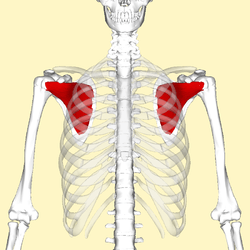 Subscapularis muscle (in red). Ribs are shown as semi-transparent. | |
| Details | |
| Latin | Musculus subscapularis |
| Subscapular fossa | |
| Lesser tubercle of humerus | |
| subscapular artery | |
| Upper subscapular nerve, lower subscapular nerve (C5, C6) | |
| Actions | Internally (medially) rotates humerus; stabilizes shoulder |
| Identifiers | |
| Gray's | p.440 |
| Dorlands /Elsevier | m_22/12551017 |
| TA | A04.6.02.012 |
| FMA | 13413 |
| Anatomical terms of muscle | |
The subscapularis is a large triangular muscle which fills the subscapular fossa and inserts into the lesser tubercle of the humerus and the front of the capsule of the shoulder-joint.
Structure
It arises from its medial two-thirds and from the lower two-thirds of the groove on the axillary border (subscapular fossa) of the scapula.
Some fibers arise from tendinous laminae which intersect the muscle and are attached to ridges on the bone; others from an aponeurosis, which separates the muscle from the teres major and the long head of the triceps brachii.
The fibers pass laterally and coalesce into a tendon which inserts into the lesser tubercle of the humerus and the anterior part of the shoulder-joint capsule.
Relations
The tendon of the muscle is separated from the neck of the scapula by a large bursa, which communicates with the cavity of the shoulder-joint through an aperture in the capsule.
Innervation
Innervation to subscapularis is supplied by the upper and lower subscapular nerves, branches of the posterior cord of the brachial plexus. (C5-C7)
Function
The subscapularis rotates the head of the humerus medially (internal rotation); when the arm is raised, it draws the humerus forward and downward. It is a powerful defense to the front of the shoulder-joint, preventing displacement of the head of the humerus.
Clinical significance
Examination
The Gerber Lift-off test is the established clinical test for examination of the subscapularis. The bear hug test (internal rotation while palm is held on opposite shoulder and elbow is held in a position of maximal anterior translation) for subscapularis muscle tears has high sensitivity. Positive bear-hug and belly press tests indicate significant tearing of subscapularis.[1]
Imaging
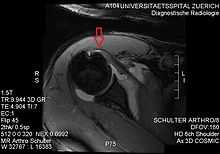
Although the subscapularis is the major and most powerful muscle of the rotator cuff and has an enormous meaning in the gleno-humeral stability and dynamic it is neglected in the clinical literature. Despite its importance and impact on conservative or surgical treatment, operative planning and approach or post-surgical prognosis. Lo and Burkhart even tagged the subscapularis tendon hypercritically as the "forgotten tendon". That arises by the gap of the described tear prevalence in cadavers between 29 and 37% and in clinical studies around 27%. This is likely related to the difficulties in radiological, arthroscopic and even open surgical assessment of this particular muscle and its tendon, especially for inferior tears. For example even full-thickness tears can be mimicked by intact tendon fibers or overlying scars attached to the greater tuberosity. Since the strong stabilizing effect of the coraco-humeral ligament a possible muscle retraction can be expeditiously underestimated. Scar tissue can be adulterant for MR Arthrographic images, as it may prevent leakage of contrast material.
There is no singularly imaging device or technique for a satisfying and complete subscapularis examination, but rather the combination of the sagittal oblique MRI / short-axis US and axial MRI / long-axis US planes seems to generate useful results. Additionally lesser tuberosity bony changes have been associated with subscapularis tendon tears. Findings with cysts seem to be more specific and combined findings with cortical irregularities more sensitive.[2]
Another fact typically for the subscapularis muscle is the fatty infiltration of the superior portions, while sparing the inferior portions.
Since the long biceps tendon absents itself from the shoulder joint through the rotator cuff interval it is easily possible to distinguish between the supraspinatus and the subscapularis tendon. Those two tendons build the interval sling.
Ultrasonography
Mack et al. developed an ultrasonographic procedure with which it is possible to explore almost the complete rotator cuff within six steps. It unveils clearly the whole area from the subedge of the subscapularis tendon until the intersection between infraspinatus tendon and musculus teres minor. One of six steps does focus on the subscapularis tendon. In the first instance the examinator guides the applicator to the proximal humerus as perpendicularly as possible to the sulcus intertubercularis. Gliding now medially shows the insertion of the subscapularis tendon.[3]
Longitudinal plane of the musculus subscapularis and its tendon The subscapularis tendon lies approximately 3 to 5 centimeter under the surface. Quite deep for ultrasonogaphy, and therefore displaying through a highly penetrative 5 MHz linear applicator is worth a try. And it really turned out to ease a detailed examination of the muscle which just abuts to the scapula. However, the so primarily interested tendon does not get mapped as closely as desired. As anatomical analysis showed, it is only by external rotation possible to see the ventral part of the joint socket and its labrum. While at the neutral position the tuberculum minus occludes the view. Summing up it is through an external arm rotation and a medially applied 5 MHz sector sonic head possible to display the ventral part of the joint socket and its labrum with notedly lower echogenicity.[4]
The following sectional planes are defined for the sonographic examination of the different shoulder joint structures:[5]
| ventral transversal | ventral sagittal medial | ventral sagittal lateral | lateral coronal | lateral transversal/sagittal: | dorsal transversal | dorsal sagittal |
|---|---|---|---|---|---|---|
| subscapularis muscle (longitudinal) | subscapularis muscle (transversal) | Intertub. sulcus with long head of biceps brachii (longitudinal) | supraspinatus muscle (longitudinal) | supraspinatus muscle (transversal) | infraspinatus muscle (longitudinal) | supraspinatus muscle (transversal) |
| Intertubercular sulcus with long head of biceps brachii (transversal) | Hill-Sachs-Lesio |
THI - Tissue Harmonic Imaging
Primarily in abdominal imaging, tissue harmonic imaging THI gets more and more valued and used additionally to conventional ultrasonography.
THI involves the use of harmonic frequencies that originate within the tissue as a result of nonlinear wave front propagation and are not present in the incident beam. These harmonic signals may arise differently at anatomic sites with similar impedances and thus lead to higher contrast resolution.” Along with higher contrast resolution it has an elevated signal-to-noise ratio and significantly reduced inter- and intraobserver variability compared with conventional US. Additionally it is possible to nearly eliminate ordinary US artifacts, i.e. side-lobe, near-field artifacts, reverberation artifacts. As aforementioned THI has already led to enhanced abdominal, breast, vascular and cardiac sonography.
For musculo-skeletal aspects THI has not been used that much, although this method features some useful potential. For example for the still tricky discrimination between presence of a hypo echoic defect and or loss of the outer tendon convexity / no visualization of the tendon, that is between partial- / full-thickness rotator cuff tears.
In comparison to a checking MR Arthrography Strobel K. et al. has arrived at the conclusion that through THI it is possible to achieve a generally improved visibility of joint and tendon surfaces, especially superior for subscapularis tendon abnormalities.[6]
Additional images
-
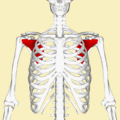
Subscapularis muscle (shown in red). Animation.
-

Same as the left. But the bones around the muscle are shown as semi-transparent.
-
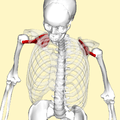
Subscapularis muscle (in red) seen from above.
-

Subscapularis muscle
-
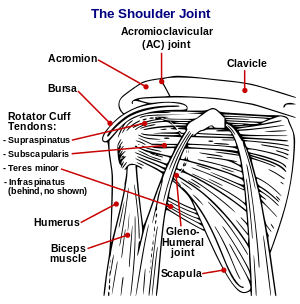
Diagram of the human shoulder joint
-
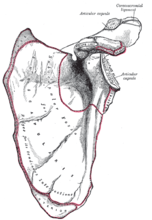
Left scapula. Costal surface.
-
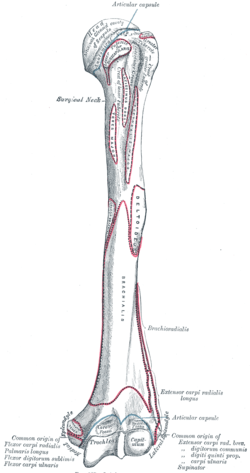
Left humerus. Anterior view.
-
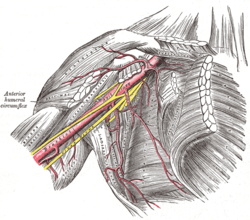
The axillary artery and its branches.
-
Subscapularis muscle
References
This article incorporates text in the public domain from the 20th edition of Gray's Anatomy (1918)
- ↑ New Zealand Society of Physiotherapists' SPNZ
- ↑ Morag Y. et al.. The subscapularis: anatomy, injury, and imaging. Skeletal Radiol. 2009 Dec 22. [Epub ahead of print].
- ↑ Mack LA. et al.. US evaluation of the rotator cuff. Radiology. 1985 Oct;157(1):205-9. @Katthagen BD. et al.. Schultersonographie. Stuttgart. ISBN 3-13-719401-6
- ↑ Katthagen BD. et al.. Schultersonographie. Stuttgart. ISBN 3-13-719401-6
- ↑ Thelen M. et al.. Radiologische Diagnostik der Verletzungen von Knochen und Gelenken. Stuttgart [etc.]. Georg Thieme. 1993. ISBN 3-13-778701-7
- ↑ Strobel K. et al.. Suspected rotator cuff lesions: tissue harmonic imaging versus conventional US of the shoulder. Radiology. 2004 Jan;230(1):243-9. Epub 2003 Nov 20.
External links
| Wikimedia Commons has media related to Subscapularis muscles. |
- ‹The template EMedicineDictionary is being considered for deletion.› Subscapularis+muscle at eMedicine Dictionary
| ||||||||||||||||||||||||||||||||||||||||||||||||||||||||||||||||||||||||||||||||||||||||||||||||||||||
